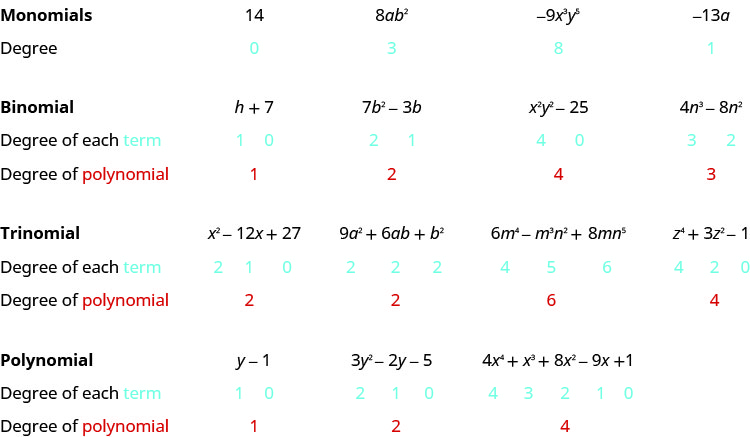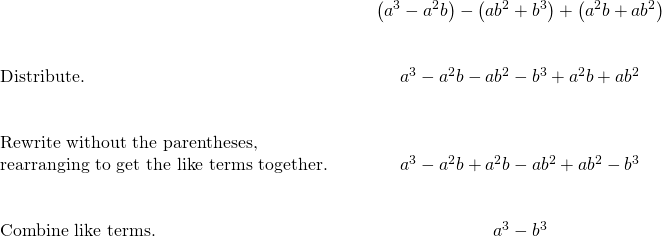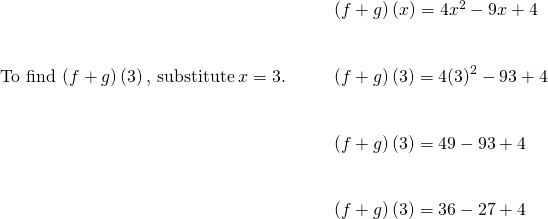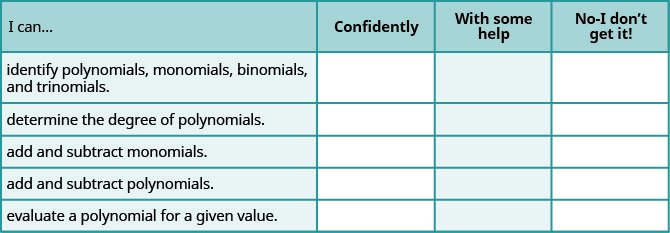Polynomials and Polynomial Functions
Add and Subtract Polynomials
Learning Objectives
By the end of this section, you will be able to:
- Determine the degree of polynomials
- Add and subtract polynomials
- Evaluate a polynomial function for a given value
- Add and subtract polynomial functions
Before you get started, take this readiness quiz.
Determine the Degree of Polynomials
We have learned that a term is a constant or the product of a constant and one or more variables. A monomial is an algebraic expression with one term. When it is of the form ![]() where a is a constant and m is a whole number, it is called a monomial in one variable. Some examples of monomial in one variable are. Monomials can also have more than one variable such as and
where a is a constant and m is a whole number, it is called a monomial in one variable. Some examples of monomial in one variable are. Monomials can also have more than one variable such as and ![]()
A monomial is an algebraic expression with one term.
A monomial in one variable is a term of the form ![]() where a is a constant and m is a whole number.
where a is a constant and m is a whole number.
A monomial, or two or more monomials combined by addition or subtraction, is a polynomial. Some polynomials have special names, based on the number of terms. A monomial is a polynomial with exactly one term. A binomial has exactly two terms, and a trinomial has exactly three terms. There are no special names for polynomials with more than three terms.
polynomial—A monomial, or two or more algebraic terms combined by addition or subtraction is a polynomial.
monomial—A polynomial with exactly one term is called a monomial.
binomial—A polynomial with exactly two terms is called a binomial.
trinomial—A polynomial with exactly three terms is called a trinomial.
Here are some examples of polynomials.
| Polynomial | ||||
| Monomial | 14 | |||
| Binomial | ||||
| Trinomial |
Notice that every monomial, binomial, and trinomial is also a polynomial. They are just special members of the “family” of polynomials and so they have special names. We use the words monomial, binomial, and trinomial when referring to these special polynomials and just call all the rest polynomials.
The degree of a polynomial and the degree of its terms are determined by the exponents of the variable.
A monomial that has no variable, just a constant, is a special case. The degree of a constant is 0.
The degree of a term is the sum of the exponents of its variables.
The degree of a constant is 0.
The degree of a polynomial is the highest degree of all its terms.
Let’s see how this works by looking at several polynomials. We’ll take it step by step, starting with monomials, and then progressing to polynomials with more terms.
Let’s start by looking at a monomial. The monomial ![]() has two variables a and b. To find the degree we need to find the sum of the exponents. The variable a doesn’t have an exponent written, but remember that means the exponent is 1. The exponent of b is 2. The sum of the exponents,
has two variables a and b. To find the degree we need to find the sum of the exponents. The variable a doesn’t have an exponent written, but remember that means the exponent is 1. The exponent of b is 2. The sum of the exponents, ![]() is 3 so the degree is 3.
is 3 so the degree is 3.

Here are some additional examples.

Working with polynomials is easier when you list the terms in descending order of degrees. When a polynomial is written this way, it is said to be in standard form of a polynomial. Get in the habit of writing the term with the highest degree first.
Determine whether each polynomial is a monomial, binomial, trinomial, or other polynomial. Then, find the degree of each polynomial.
ⓐ![]() ⓑ
ⓑ![]() ⓒ
ⓒ![]() ⓓ
ⓓ![]() ⓔ 15
ⓔ 15
| Polynomial | Number of terms | Type | Degree of terms | Degree of polynomial | |
|---|---|---|---|---|---|
| ⓐ | 3 | Trinomial | 2, 1, 0 | 2 | |
| ⓑ | 1 | Monomial | 4, 2 | 6 | |
| ⓒ | 5 | Polynomial | 5, 3, 2, 1, 0 | 5 | |
| ⓓ | 2 | Binomial | 1, 4 | 4 | |
| ⓔ | 15 | 1 | Monomial | 0 | 0 |
Determine whether each polynomial is a monomial, binomial, trinomial, or other polynomial. Then, find the degree of each polynomial.
ⓐ![]() ⓑ
ⓑ![]() ⓒ
ⓒ![]() ⓓ
ⓓ![]() ⓔ
ⓔ![]()
ⓐ monomial, 0
ⓑ polynomial, 3 ⓒ trinomial, 3
ⓓ binomial, 2 ⓔ monomial, 10
Determine whether each polynomial is a monomial, binomial, trinomial, or other polynomial. Then, find the degree of each polynomial.
ⓐ![]() ⓑ
ⓑ![]() ⓒ
ⓒ![]() ⓓ
ⓓ![]() ⓔ
ⓔ![]()
ⓐbinomial, 3 ⓑ trinomial, 3 ⓒ monomial, 0 ⓓ polynomial, 4 ⓔ monomial, 7
Add and Subtract Polynomials
We have learned how to simplify expressions by combining like terms. Remember, like terms must have the same variables with the same exponent. Since monomials are terms, adding and subtracting monomials is the same as combining like terms. If the monomials are like terms, we just combine them by adding or subtracting the coefficients.
Add or subtract: ⓐ ![]() ⓑ
ⓑ ![]()
ⓐ
![]()
ⓑ
![]()
Add or subtract: ⓐ ![]() ⓑ
ⓑ ![]()
ⓐ![]() ⓑ
ⓑ![]()
Add or subtract: ⓐ ![]() ⓑ
ⓑ ![]()
ⓐ![]() ⓑ
ⓑ![]()
Remember that like terms must have the same variables with the same exponents.
Simplify: ⓐ ![]() ⓑ
ⓑ ![]()
ⓐ
![]()
ⓑ

Add: ⓐ ![]() ⓑ
ⓑ ![]()
ⓐ![]()
ⓑ![]()
Add: ⓐ ![]() ⓑ
ⓑ ![]()
ⓐ![]()
ⓑ![]()
We can think of adding and subtracting polynomials as just adding and subtracting a series of monomials. Look for the like terms—those with the same variables and the same exponent. The Commutative Property allows us to rearrange the terms to put like terms together.
Find the sum:![]()
![]()
Find the sum: ![]()
![]()
Find the sum: ![]()
![]()
Be careful with the signs as you distribute while subtracting the polynomials in the next example.
Find the difference: ![]()
*** QuickLaTeX cannot compile formula:
\begin{array}{cccc}& & & \hfill \left(9{w}^{2}-7w+5\right)-\left(2{w}^{2}-4\right)\hfill \\ \text{Distribute and identify like terms.}\hfill & & & \hfill \underset{____}{\underset{____}{9{w}^{2}}}-\underset{___}{7w}+5-\underset{____}{\underset{____}{2{w}^{2}}}+4\hfill \\ \text{Rearrange the terms.}\hfill & & & \hfill \underset{__________}{\underset{__________}{9{w}^{2}-2{w}^{2}}}-\underset{___}{7w}+5+4\hfill \\ \text{Combine like terms.}\hfill & & & \hfill 7{w}^{2}-7w+9\hfill \end{array}
*** Error message:
Missing { inserted.
leading text: ... \underset{____}{\underset{____}{9{w}^{2}}}
Missing { inserted.
leading text: ... \underset{____}{\underset{____}{9{w}^{2}}}
Missing { inserted.
leading text: ... \underset{____}{\underset{____}{9{w}^{2}}}
Missing { inserted.
leading text: ... \underset{____}{\underset{____}{9{w}^{2}}}
Missing } inserted.
leading text: ... \underset{____}{\underset{____}{9{w}^{2}}}
Missing } inserted.
leading text: ... \underset{____}{\underset{____}{9{w}^{2}}}
Missing } inserted.
leading text: ... \underset{____}{\underset{____}{9{w}^{2}}}
Missing } inserted.
leading text: ... \underset{____}{\underset{____}{9{w}^{2}}}
Missing { inserted.
leading text: ... \underset{____}{\underset{____}{9{w}^{2}}}
Missing { inserted.
leading text: ... \underset{____}{\underset{____}{9{w}^{2}}}
Find the difference: ![]()
![]()
Find the difference: ![]()
![]()
To subtract ![]() from
from ![]() we write it as
we write it as ![]() placing the
placing the ![]() first.
first.
Subtract ![]() from
from ![]()

Subtract ![]() from
from ![]()
![]()
Subtract ![]() from
from ![]()
![]()
Find the sum: ![]()

Find the sum: ![]()
![]()
Find the sum: ![]()
![]()
When we add and subtract more than two polynomials, the process is the same.
Simplify: ![]()

Simplify: ![]()
![]()
Simplify: ![]()
![]()
Evaluate a Polynomial Function for a Given Value
A polynomial function is a function defined by a polynomial. For example, ![]() and
and ![]() are polynomial functions, because
are polynomial functions, because ![]() and
and ![]() are polynomials.
are polynomials.
A polynomial function is a function whose range values are defined by a polynomial.
In Graphs and Functions, where we first introduced functions, we learned that evaluating a function means to find the value of ![]() for a given value of x. To evaluate a polynomial function, we will substitute the given value for the variable and then simplify using the order of operations.
for a given value of x. To evaluate a polynomial function, we will substitute the given value for the variable and then simplify using the order of operations.
For the function ![]() find: ⓐ
find: ⓐ ![]() ⓑ
ⓑ ![]() ⓒ
ⓒ ![]()
ⓐ
 |
|
 |
 |
| Simplify the exponents. |  |
| Multiply. |  |
| Simplify. |  |
ⓑ
 |
|
 |
 |
| Simplify the exponents. |  |
| Multiply. |  |
| Simplify. |  |
ⓒ
 |
|
 |
 |
| Simplify the exponents. |  |
| Multiply. |  |
| Simplify. |  |
For the function ![]() find ⓐ
find ⓐ ![]() ⓑ
ⓑ ![]() ⓒ
ⓒ ![]()
ⓐ 18 ⓑ 50 ⓒ ![]()
For the function ![]() find ⓐ
find ⓐ ![]() ⓑ
ⓑ ![]() ⓒ
ⓒ ![]()
ⓐ 20 ⓑ 2 ⓒ ![]()
The polynomial functions similar to the one in the next example are used in many fields to determine the height of an object at some time after it is projected into the air. The polynomial in the next function is used specifically for dropping something from 250 ft.
The polynomial function ![]() gives the height of a ball t seconds after it is dropped from a 250-foot tall building. Find the height after
gives the height of a ball t seconds after it is dropped from a 250-foot tall building. Find the height after ![]() seconds.
seconds.

The polynomial function ![]() gives the height of a stone t seconds after it is dropped from a 150-foot tall cliff. Find the height after
gives the height of a stone t seconds after it is dropped from a 150-foot tall cliff. Find the height after ![]() seconds (the initial height of the object).
seconds (the initial height of the object).
The height is ![]() feet.
feet.
The polynomial function ![]() gives the height of a ball t seconds after it is dropped from a 175-foot tall bridge. Find the height after
gives the height of a ball t seconds after it is dropped from a 175-foot tall bridge. Find the height after ![]() seconds.
seconds.
The height is 31 feet.
Add and Subtract Polynomial Functions
Just as polynomials can be added and subtracted, polynomial functions can also be added and subtracted.
For functions ![]() and
and ![]()
For functions ![]() and
and ![]() find:
find:
ⓐ![]() ⓑ
ⓑ![]() ⓒ
ⓒ![]() ⓓ
ⓓ![]()
ⓐ
 |
|
 |
 |
| Rewrite without the parentheses. |  |
| Put like terms together. |  |
| Combine like terms. |  |
ⓑ In part (a) we found ![]() and now are asked to find
and now are asked to find ![]()

Notice that we could have found ![]() by first finding the values of
by first finding the values of ![]() and
and ![]() separately and then adding the results.
separately and then adding the results.
| Find |
 |
 |
|
 |
|
| Find |
 |
 |
|
 |
|
| Find |
 |
 |
|
 |
 |
 |
ⓒ
 |
|
 |
 |
| Rewrite without the parentheses. |  |
| Put like terms together. |  |
| Combine like terms. |  |
ⓓ
 |
For functions ![]() and
and ![]() find: ⓐ
find: ⓐ ![]() ⓑ
ⓑ ![]() ⓒ
ⓒ ![]() ⓓ
ⓓ ![]()
ⓐ![]() ⓑ
ⓑ![]()
ⓒ![]()
ⓓ![]()
For functions ![]() and
and ![]() find ⓐ
find ⓐ ![]() ⓑ
ⓑ ![]() ⓒ
ⓒ ![]() ⓓ
ⓓ ![]()
ⓐ![]() ⓑ
ⓑ![]()
ⓒ![]()
ⓓ![]()
Access this online resource for additional instruction and practice with adding and subtracting polynomials.
Key Concepts
- Monomial
- A monomial is an algebraic expression with one term.
- A monomial in one variable is a term of the form
 where a is a constant and m is a whole number.
where a is a constant and m is a whole number.
- Polynomials
- Polynomial—A monomial, or two or more algebraic terms combined by addition or subtraction is a polynomial.
- monomial —A polynomial with exactly one term is called a monomial.
- binomial — A polynomial with exactly two terms is called a binomial.
- trinomial —A polynomial with exactly three terms is called a trinomial.
- Degree of a Polynomial
- The degree of a term is the sum of the exponents of its variables.
- The degree of a constant is 0.
- The degree of a polynomial is the highest degree of all its terms.
Practice Makes Perfect
Determine the Type of Polynomials
In the following exercises, determine if the polynomial is a monomial, binomial, trinomial, or other polynomial.
ⓐ![]()
ⓑ![]()
ⓒ![]()
ⓓ 4
ⓔ ![]()
ⓐ trinomial, 5 ⓑ polynomial, 3 ⓒ binomial, 1 ⓓ monomial, 1
ⓔ binomial, 1
ⓐ![]()
ⓑ![]()
ⓒ![]()
ⓓ![]()
ⓔ 19
ⓐ![]()
ⓑ![]()
ⓒ![]()
ⓓ![]()
ⓔ![]()
ⓐ binomial ⓑ trinomial
ⓒ polynomial ⓓ trinomial
ⓔ monomial
ⓐ![]()
ⓑ![]()
ⓒ![]()
ⓓ![]()
ⓔ![]()
ⓐ![]()
ⓑ![]()
ⓒ![]()
ⓓ![]()
ⓔ![]()
ⓐ![]() ⓑ
ⓑ![]() ⓒ
ⓒ![]() ⓓ
ⓓ![]()
ⓔ![]()
ⓐ![]()
ⓑ![]()
ⓒ![]()
ⓓ![]()
ⓔ 17
ⓐ![]()
ⓑ![]()
ⓒ![]()
ⓓ![]()
ⓔ![]()
ⓐ![]() ⓑ
ⓑ![]() ⓒ
ⓒ![]() ⓓ
ⓓ![]()
ⓔ![]()
ⓐ![]()
ⓑ 15
ⓒ ![]()
ⓓ ![]()
ⓔ ![]()
Add and Subtract Polynomials
In the following exercises, add or subtract the monomials.
ⓐ![]()
ⓑ![]()
ⓐ![]() ⓑ
ⓑ![]()
ⓐ![]()
ⓑ![]()
ⓐ![]()
ⓑ![]()
ⓐ![]() ⓑ
ⓑ![]()
ⓐ![]()
ⓑ![]()
![]()
![]()
![]()
![]()
![]()
![]()
ⓐ![]()
ⓑ![]()
ⓐ![]() ⓑ
ⓑ![]()
ⓐ![]()
ⓑ![]()
ⓐ![]()
ⓑ![]()
ⓐ![]()
ⓑ![]()
ⓐ![]()
ⓑ![]()
ⓐ![]()
ⓑ![]()
ⓐ![]()
ⓑ![]()
ⓐ![]()
ⓑ![]()
ⓐ![]()
ⓑ![]()
ⓐ![]()
ⓑ![]()
![]()
![]()
![]()
![]()
![]()
![]()
![]()
Add: ![]()
![]()
Add:![]()
Subtract ![]() from
from ![]()
![]()
Subtract ![]() from
from ![]()
In the following exercises, add the polynomials.
![]()
![]()
![]()
![]()
![]()
![]()
![]()
![]()
![]()
![]()
![]()
![]()
In the following exercises, subtract the polynomials.
![]()
![]()
![]()
![]()
![]()
![]()
![]()
![]()
![]()
In the following exercises, subtract the polynomials.
Subtract ![]() from
from ![]()
![]()
Subtract ![]() from
from ![]()
Subtract ![]() from
from ![]()
![]()
Subtract ![]() from
from ![]()
In the following exercises, find the difference of the polynomials.
Find the difference of ![]() and
and ![]()
![]()
Find the difference of ![]() and
and ![]()
In the following exercises, add the polynomials.
![]()
![]()
![]()
![]()
![]()
![]()
In the following exercises, add or subtract the polynomials.
![]()
![]()
![]()
![]()
![]()
![]()
![]()
![]()
![]()
Evaluate a Polynomial Function for a Given Value
In the following exercises, find the function values for each polynomial function.
For the function ![]() find:
find:
ⓐ ![]() ⓑ
ⓑ ![]() ⓒ
ⓒ ![]()
ⓐ 187 ⓑ 40 ⓒ 2
For the function ![]() find:
find:
ⓐ ![]() ⓑ
ⓑ ![]() ⓒ
ⓒ ![]()
For the function ![]() find:
find:
ⓐ ![]() ⓑ
ⓑ ![]() ⓒ
ⓒ ![]()
ⓐ![]() ⓑ 4 ⓒ 40
ⓑ 4 ⓒ 40
For the function ![]() find:
find:
ⓐ ![]() ⓑ
ⓑ ![]() ⓒ
ⓒ ![]()
In the following exercises, find the height for each polynomial function.
A painter drops a brush from a platform 75 feet high. The polynomial function ![]() gives the height of the brush t seconds after it was dropped. Find the height after
gives the height of the brush t seconds after it was dropped. Find the height after ![]() seconds.
seconds.
The height is 11 feet.
A girl drops a ball off the cliff into the ocean. The polynomial ![]() gives the height of a ball t seconds after it is dropped. Find the height after
gives the height of a ball t seconds after it is dropped. Find the height after ![]() seconds.
seconds.
A manufacturer of stereo sound speakers has found that the revenue received from selling the speakers at a cost of p dollars each is given by the polynomial function ![]() Find the revenue received when
Find the revenue received when ![]() dollars.
dollars.
The revenue is ?10,800.
A manufacturer of the latest basketball shoes has found that the revenue received from selling the shoes at a cost of p dollars each is given by the polynomial ![]() Find the revenue received when
Find the revenue received when ![]() dollars.
dollars.
The polynomial ![]() gives the cost, in dollars, of producing a rectangular container whose top and bottom are squares with side x feet and height 6 feet. Find the cost of producing a box with
gives the cost, in dollars, of producing a rectangular container whose top and bottom are squares with side x feet and height 6 feet. Find the cost of producing a box with ![]() feet.
feet.
The cost is ?456.
The polynomial ![]() gives the cost, in dollars, of producing a rectangular container whose top and bottom are squares with side x feet and height 4 feet. Find the cost of producing a box with
gives the cost, in dollars, of producing a rectangular container whose top and bottom are squares with side x feet and height 4 feet. Find the cost of producing a box with ![]() feet.
feet.
Add and Subtract Polynomial Functions
In each example, find ⓐ (f + g)(x) ⓑ (f + g)(2) ⓒ (f − g)(x) ⓓ (f − g)(−3).
![]() and
and ![]()
ⓐ![]() ⓑ
ⓑ![]()
ⓒ![]()
ⓓ![]()
![]() and
and ![]()
![]() and
and ![]()
ⓐ ![]()
ⓑ![]()
ⓒ![]()
ⓓ![]()
![]() and
and ![]()
Writing Exercises
Using your own words, explain the difference between a monomial, a binomial, and a trinomial.
Answers will vary.
Using your own words, explain the difference between a polynomial with five terms and a polynomial with a degree of 5.
Ariana thinks the sum ![]() is
is ![]() What is wrong with her reasoning?
What is wrong with her reasoning?
Answers will vary.
Is every trinomial a second degree polynomial? If not, give an example.
Self Check
ⓐ After completing the exercises, use this checklist to evaluate your mastery of the objectives of this section.

ⓑ If most of your checks were:
…confidently. Congratulations! You have achieved the objectives in this section. Reflect on the study skills you used so that you can continue to use them. What did you do to become confident of your ability to do these things? Be specific.
…with some help. This must be addressed quickly because topics you do not master become potholes in your road to success. In math every topic builds upon previous work. It is important to make sure you have a strong foundation before you move on. Who can you ask for help? Your fellow classmates and instructor are good resources. Is there a place on campus where math tutors are available? Can your study skills be improved?
…no – I don’t get it! This is a warning sign and you must not ignore it. You should get help right away or you will quickly be overwhelmed. See your instructor as soon as you can to discuss your situation. Together you can come up with a plan to get you the help you need.
Glossary
- binomial
- A binomial is a polynomial with exactly two terms.
- degree of a constant
- The degree of any constant is 0.
- degree of a polynomial
- The degree of a polynomial is the highest degree of all its terms.
- degree of a term
- The degree of a term is the sum of the exponents of its variables.
- monomial
- A monomial is an algebraic expression with one term. A monomial in one variable is a term of the form
 where a is a constant and m is a whole number.
where a is a constant and m is a whole number.
- polynomial
- A monomial or two or more monomials combined by addition or subtraction is a polynomial.
- standard form of a polynomial
- A polynomial is in standard form when the terms of a polynomial are written in descending order of degrees.
- trinomial
- A trinomial is a polynomial with exactly three terms.
- polynomial function
- A polynomial function is a function whose range values are defined by a polynomial.

